by Laurel Rabschutz
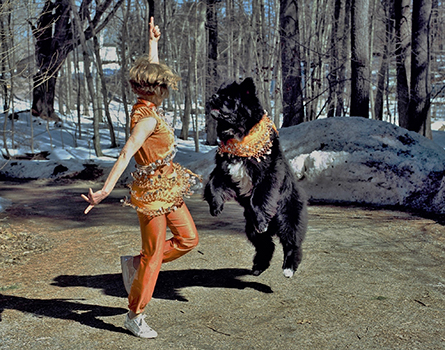 You and your partner take your place on the floor, your choreographed routine flashes through your mind, you take a couple of deep breaths, you look into your partner's eyes for reassurance, the familiar music starts and off you go. This scenario may bring to mind pairs figure skating or ballroom dancing; but what if I told you that your partner is your dog. Then it can only be one thing: musical canine freestyle!
You and your partner take your place on the floor, your choreographed routine flashes through your mind, you take a couple of deep breaths, you look into your partner's eyes for reassurance, the familiar music starts and off you go. This scenario may bring to mind pairs figure skating or ballroom dancing; but what if I told you that your partner is your dog. Then it can only be one thing: musical canine freestyle!
Canine freestyle is a blend of traditional obedience and non-traditional "dance" movements performed to music. Teamwork between dog and handler is essential. Freestyle is a wonderful way to demonstrate your dog's intelligence, skills, beauty and fun-loving spirit. For me, it was love at first sight when I discovered freestyle at a Gaines Regional Trial in 1994.
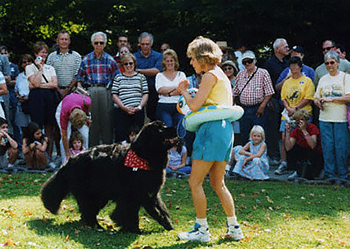 Getting started in freestyle is as simple as finding a tune you can easily walk (i.e. heel) to. A sense of rhythm and balance is helpful, but no formal training is necessary. The type of music used is your choice. Show tunes, big band, rock-n-roll, opera, country /western, folk tunes, and (dare I say it) even disco have all been used. Be sure it is a tune you really enjoy, as you will listen to it hundreds of times! Most routines are two to three minutes long.
Getting started in freestyle is as simple as finding a tune you can easily walk (i.e. heel) to. A sense of rhythm and balance is helpful, but no formal training is necessary. The type of music used is your choice. Show tunes, big band, rock-n-roll, opera, country /western, folk tunes, and (dare I say it) even disco have all been used. Be sure it is a tune you really enjoy, as you will listen to it hundreds of times! Most routines are two to three minutes long.
Choose music that reflects the personality of the team. For example, our most popular routine is "Rescue Me." I chose this music not only because it has a good beat and nice transitions, but to make a connection to the water rescue abilities of my Newfoundland partner, Gus (Ebunyzar's Gustav Mauler, CD, WRD, Delta Pet Partner). We even use a "take-a-line" bumper as a prop. The music should also be appropriate for the intended audience (if any). Our first performance of "Rescue Me" was at the 1997 NCNE water test.
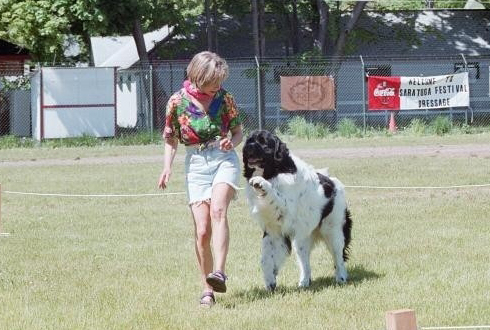 No special training is necessary for the canine partner, either. And trust me - dogs love it! Even that lagging, half asleep CD never-to-be can be motivated by simple freestyle moves. Think about some of the movements, tricks or behaviors that your dog already knows and how those could be incorporated into a freestyle routine. Does your dog know how to bow, roll over or hi-five? Does your dog know "around" from water work, "back" from draft work, a swing finish or a drop on recall from obedience? These are all movements used by freestyle teams. Practicing those spins, bows and weaves have the added benefit of keeping your dog flexible and agile.
No special training is necessary for the canine partner, either. And trust me - dogs love it! Even that lagging, half asleep CD never-to-be can be motivated by simple freestyle moves. Think about some of the movements, tricks or behaviors that your dog already knows and how those could be incorporated into a freestyle routine. Does your dog know how to bow, roll over or hi-five? Does your dog know "around" from water work, "back" from draft work, a swing finish or a drop on recall from obedience? These are all movements used by freestyle teams. Practicing those spins, bows and weaves have the added benefit of keeping your dog flexible and agile.
Teach your dog freestyle movements just as you would any behavior. Break it down into small pieces, use lots of motivational aids (toys, food) and praise, praise, praise when you get the desired behavior. Then practice, practice, practice-indoors, outdoors, shopping malls, school yards. Yes, the neighbors will think you're a mental patient, but you own a Newf so they probably already think that. If you're interested in attending a class, check the listings under "resources" for freestyle seminars or workshops in your area.
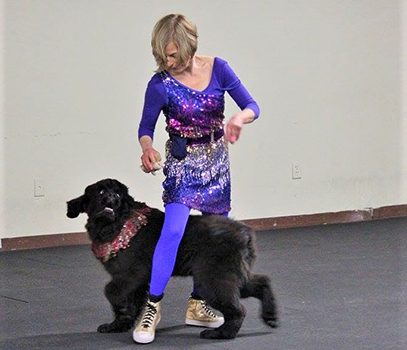 I like to work out pieces of a routine in my head and then jot them down on graph paper. Next I will try to walk through it solo, then finally add my canine partner. Revisions are constantly being made. Actually, we never perform the same routine twice-at least Gus doesn't. Gus loves to improvise and will toss in a spin or change direction when I least expect it. He will often invent his own moves and sometimes they just become part of the routine.
I like to work out pieces of a routine in my head and then jot them down on graph paper. Next I will try to walk through it solo, then finally add my canine partner. Revisions are constantly being made. Actually, we never perform the same routine twice-at least Gus doesn't. Gus loves to improvise and will toss in a spin or change direction when I least expect it. He will often invent his own moves and sometimes they just become part of the routine.
Freestyle can be just for fun in your own back yard, for competition, or anything in between. Senior centers, nursing homes and children's groups are amazed and delighted by the simplest routine. We do the "Hokey-Pokey" and get everyone involved. If you don't want to go it alone, join a team. Doggy square dance and freestyle teams are great fun involving people and dogs of all sizes and shapes. If you have the gumption, do some demos or enter a competition. For demos, just about anything goes. Competitions have specific requirements and rules and regulations.
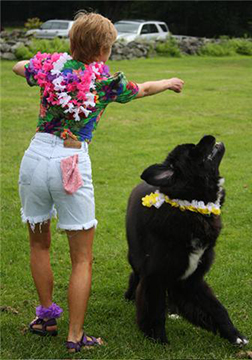 Canine freestyle is a fun and rapidly growing sport. It had its beginning in Canada in the early '90s and quickly spread to the U.S.
Canine freestyle is a fun and rapidly growing sport. It had its beginning in Canada in the early '90s and quickly spread to the U.S.
One of the best ways to understand what canine freestyle is all about is to watch some live or video performances. Perhaps you will become hooked as I did. Oh, you'll get strange looks from people when nursing home residents or school children tell their families about how you dance with your dog, but you and your dog will have the best times of your lives. And who could ask for anything more!
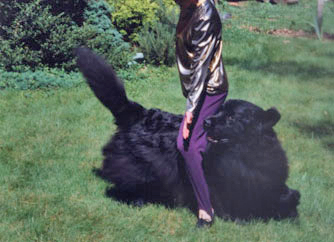
reprinted from NewfTide 2000